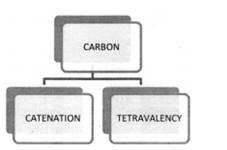
- Carbon is a versatile element. Found in .02% in form of minerals an 03% in form of CO2.
- All living structures are carbon-based.
Covalent Bond in Carbon
- The atomic number of carbon is 6 and its electronic configuration is 2, 4. To attain a noble gas configuration it requires four more electrons in its valence shell.
- It is difficult for an atom of carbon to either gain or loses electrons as it would be difficult to hold extra electrons and would require a large amount of energy to remove four electrons.
- Carbon attains the noble gas configuration by sharing its valence electrons with other atoms. Such mutual sharing of electrons between atoms to attain a stable noble gas configuration is called Covalent bonding.
- Atoms of other elements like hydrogen, oxygen, nitrogen, chlorine also show sharing of valence electrons.
Depending on the number of electron pairs shared, the covalent bond is of three types :
- Single Covalent Bond: Single covalent bond is formed because of sharing of two electrons,i.e one pair. Example: Hydrogen, Chlorine, Methane.
- Double covalent bond: Double bond is formed by sharing of four electrons,i.e two pairs of electrons. Example: Oxygen molecule, Carbon Dioxide molecule.
- Triple Covalent Bond: Triple covalent bond is formed because of the sharing of six electrons, three pairs of electrons.example: Nitrogen, C2H2
Properties of Covalent Bonds
- Covalently bonded molecules have low melting and boiling points.
- Comparatively weaker intermolecular forces, unlike ionic compounds.
- These molecules are generally a poor conductor of electricity since no charged particles are formed.
- Two important properties which enable carbon to form an enormously large number of compounds.

Catenation
- It is a property of carbon atom to form a bond with other atoms of carbon. Like carbon, silicon forms compounds with hydrogen up to seven or eight atoms of silicon called silanes.
Tetravalency
- Having a valency of 4, the carbon atom is capable of bonding with atoms of oxygen, hydrogen, nitrogen, sulphur, chlorine and other elements. Since it requires four electrons, carbon is said to be tetravalent.
- a smaller size of carbon atom enables nucleus to hold the shared pair of electrons strongly, thus carbon compounds are very stable in general.

